Layman D. Biology Demystified: A Self-Teaching Guide
Подождите немного. Документ загружается.

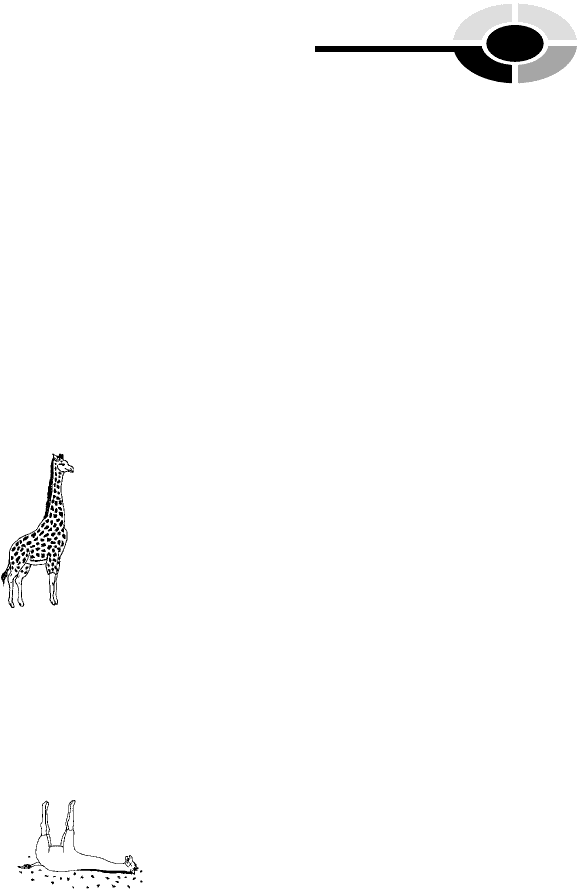
(c) Frequently appears on lawns as groups of fairy ring mushrooms
(d) Is a typical club fungus
10. A lichen:
(a) Is a type of green plant (roughly the same thing as moss)
(b) Exists as a symbiotic combination of fungi with algae or bacteria
(c) May be too delicate to live in harsh climates
(d) Basically is the fruiting body of an alga
The Giraffe ORDER TABLE for Chapter 8
(Key Text Facts About Biological Order Within An Organism)
1. ____________________________________________________________
The Dead Giraffe DISORDER TABLE for Chapter 8
(Key Text Facts About Biological Disorder Within An Organism)
1. ____________________________________________________________
2. ____________________________________________________________
3. ____________________________________________________________
CHAPTER 8 Fungi: Not Just Mushrooms 137
[13:24 13/6/03 N:/4058 LAYMAN.751/4058-Alltext.3d] Ref: 4058 Layman: Biology Demystified All-text Page: 137 1-388
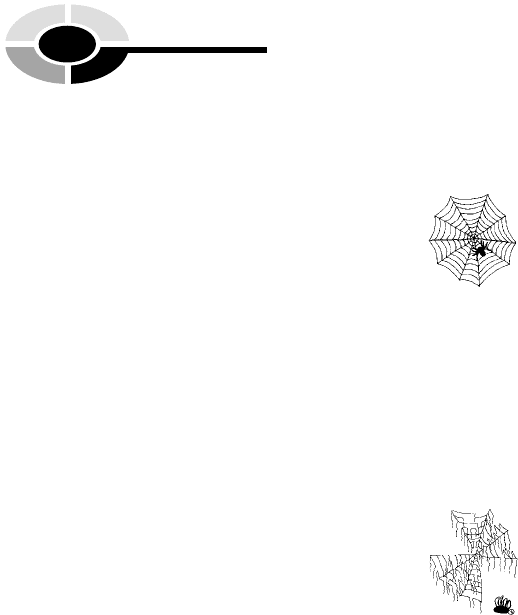
The Spider Web ORDER TABLE for Chapter 8
(Key Text Facts About Biological Order Beyond The Individual
Organism)
1. ____________________________________________________________
2. ____________________________________________________________
The Broken Spider Web DISORDER TABLE for Chapter 8
(Key Text Facts About Biological Disorder Beyond The Individual
Organism)
1. ____________________________________________________________
2. ____________________________________________________________
[13:24 13/6/03 N:/4058 LAYMAN.751/4058-Alltext.3d] Ref: 4058 Layman: Biology Demystified All-text Page: 138 1-388
PART 3 Five Kingdoms of Life, plus Viruses
138
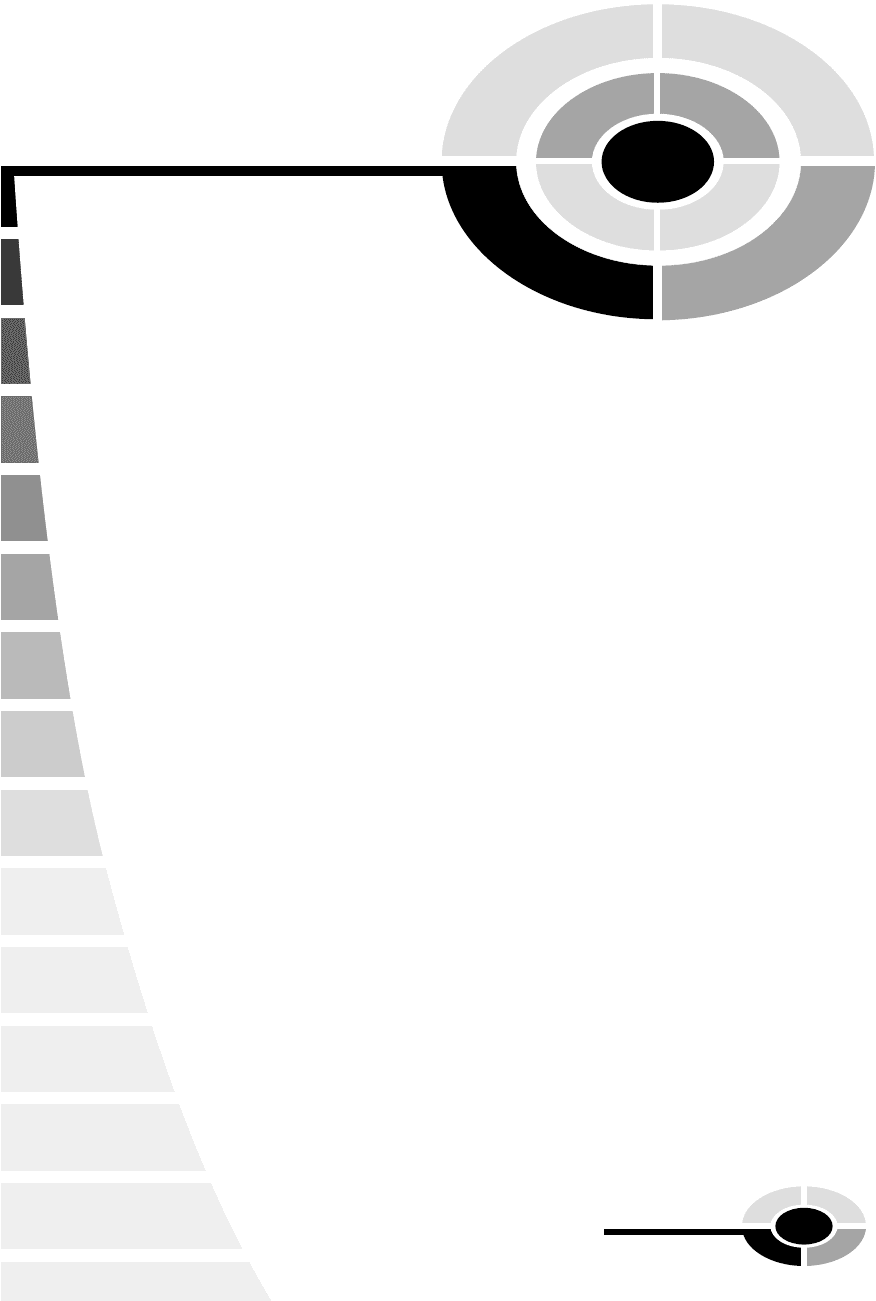
[13:24 13/6/03 N:/4058 LAYMAN.751/4058-Alltext.3d] Ref: 4058 Layman: Biology Demystified All-text Page: 139 1-388
139
CHAPTER
9
The Plants: ‘‘Kings
and Queens’’ of the
World of Green
Chapter 7 considered the protists, including the algae – primitive, plant-like
protists. And Chapter 8 took a look at the lichens as mixtures of fungi with
either algae or bluish-green bacteria. Both algae alone, and in combination
with fungi as lichens, have in common the presence of chlorophyll. This
pigment, of course, is the main molecule responsible for photosynthesis,
and for producing the greenish color of these organisms.
The Human Sole–Plant Connection
Recall (Chapter 3) that the word plant literally means ‘‘a sprout.’’ It comes
from the Ancient Latin term planta, which also translates to mean ‘‘sole of
Copyright 2003 by The McGraw-Hill Companies, Inc. Click Here for Terms of Use.
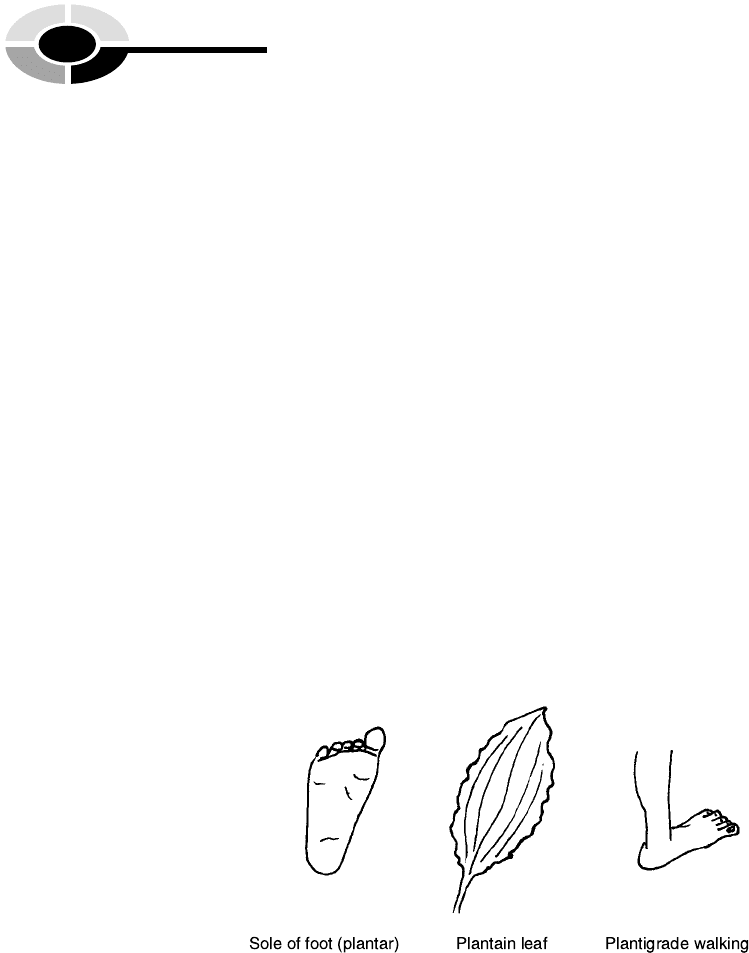
the foot’’! Quite fascinating is the connection to another term plantigrade
(PLAN-tuh-grade) – ‘‘walking’’ (-grade) on the ‘‘sole of the foot’’ (planti).
Human beings, bears, and raccoons are all mammals that share the common
trait of being plantigrade. Specifically, these mammals all walk with the entire
sole of each foot firmly ‘‘planted’’ upon the ground! It seems likely that the
early Greek botanists (BAHT-uh-nists), or ‘‘those who specialize in’’ (-ists)
‘‘plants’’ (botan), were the ones who made this connection. Thus, we have
humans who walk in a plantigrade manner, sole of the feet placed flat upon
the ground. And from this same ground, up sprout the green plants!
This close anatomic and naming connection between the sole of the human
foot and the plants springing up from the ground has also been extended to
the names of some individual plants. Consider, for instance, the plant genus
called plantain (PLAN-tun). As Figure 9.1 shows, the common or broad-
leaved plantain is a low-lying weed with large, light-green leaves growing
from its base. Often invading lawns, the common plantain gets its name
from the shape of its leaves, which are flat and broad like the sole of a
human foot! One can say, then, that the flat leaves of the plantain have a
very plantar (PLAN-ter) or ‘‘sole of the foot-like’’ appearance. These leaves
can be crushed underfoot by a walking human, as well as eaten by them
(blanched and saute
´
ed in butter and garlic).
Here Come the Land Plants!
Most botanists believe that modern land plants are the ancestors of primi-
tive green algae that lived along the edges of lakes or oceans. Gradually
[13:24 13/6/03 N:/4058 LAYMAN.751/4058-Alltext.3d] Ref: 4058 Layman: Biology Demystified All-text Page: 140 1-388
PART 3 Five Kingdoms of Life, plus Viruses
140
Fig. 9.1 Feet, soles, and plantains: A human–plant connection.
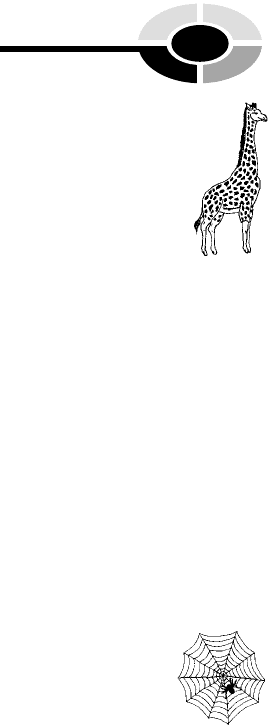
(about 450 million years ago), the land plants emerged completely from the
water, and spread across the Continents. As they evolved, they became
more and more different from their primitive algae ancestors. Technically
speaking, a plant is a multicellular organism that carries out photosynth-
esis, contains chlorophyll, and develops from an embryo (EM-bree-oh). An
embryo is literally ‘‘a sweller.’’ In general, then, an embryo represents the
earliest stages of development of any organism. A plant embryo is a partial,
undeveloped plant contained within a seed, that eventually ‘‘swells’’ into a
full plant.
There are more than 300,000 different species of plants in the world, and
the vast majority are land plants (rather than algae). A few land-based species
have apparently returned to the aquatic environment, including the slender
sea grasses. But there are so many more species of land plants compared to
algae that we have entitled this chapter The Plants: ‘‘Kings and Queens’’ of the
World of Green.
THE TWO MAJOR GROUPS OF LAND PLANTS:
CONTAINING ‘‘VESSELS,’’ OR NOT?
Land plants have a huge amount of diversity (duh-VER-suh-tee) or ‘‘turning
aside’’ (divers) from common traits. Nevertheless, a broad classification into
two main groups of plants is possible. The great majority of species make up
the vascular (VAS-kyoo-lar) plants, while a relatively few species comprise the
nonvascular (NAHN-vas-kyoo-lar) plants.
Vascular literally ‘‘pertains to’’ (-ar) ‘‘little vessels’’ (vascul). The vascular
plants are also called the tracheophytes (TRAY-kee-oh-fights) – ‘‘plants’’
(-phytes) containing ‘‘rough arteries or windpipes’’ (trache). The vascular
plants (tracheophytes) are the plants whose bodies contain many small hol-
low tubes that resemble blood vessels or windpipes (Figure 9.2, A). The
hollow tubes create a vascular (vessel-rich) tissue, which runs up and down
throughout the plant. The vascular tissue also branches outward to create
dense patterns of leaf veins along the sides of the plant.
In direct contrast to the vascular plants or tracheophytes are the nonvas-
cular plants. Their alternate name is the bryophytes (BRY-uh-fights), or ‘‘tree
moss’’ (bry-) ‘‘plants’’ (-phytes). The nonvascular plants (bryophytes) have no
internal vessels or leaf veins (Figure 9.2, B). They also lack true leaves, stems,
or roots. This nonvascular type is called bryophytes (from Latin) because the
mosses and other moss-like plants are the main examples.
CHAPTER 9 Plants: Kings and Queens 141
[13:24 13/6/03 N:/4058 LAYMAN.751/4058-Alltext.3d] Ref: 4058 Layman: Biology Demystified All-text Page: 141 1-388
1, Order
1, Web
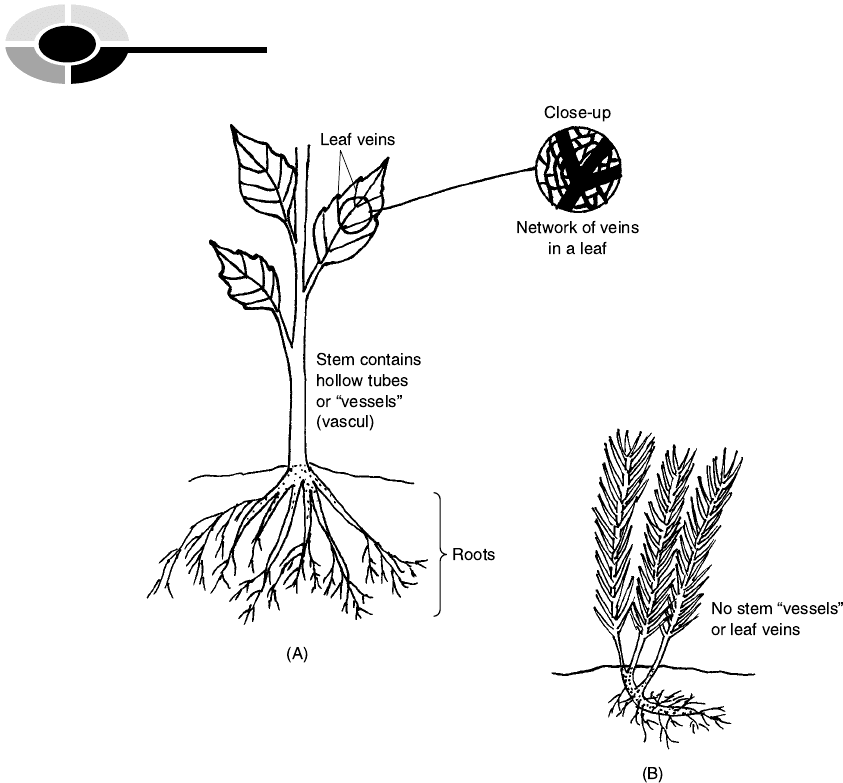
An Overview of the Bryophytes (Nonvascular
Plants)
The two most familiar types of bryophytes are the mosses and the liverworts
(LIV-er-werts). The word, moss, descends from the Old English for ‘‘bog’’ – a
marsh or swamp consisting of soft, wet, spongy ground. A moss is a very
small, soft, brown or green plant that grows closely together with others of its
kind, forming a living carpet on rocks, trees, or ground. Mosses have short
stems and many slender leaves. Decaying sphagnum (SFAG-num) moss (also
called peat moss) is especially common in bogs. Peat (PEET) is heavy turf
[13:24 13/6/03 N:/4058 LAYMAN.751/4058-Alltext.3d] Ref: 4058 Layman: Biology Demystified All-text Page: 142 1-388
PART 3 Five Kingdoms of Life, plus Viruses
142
Fig. 9.2 Two major groups of plants: (A) Vascular plants (tracheophytes) – often tall and
large. (B) Nonvascular plants (bryophytes) – short and small.
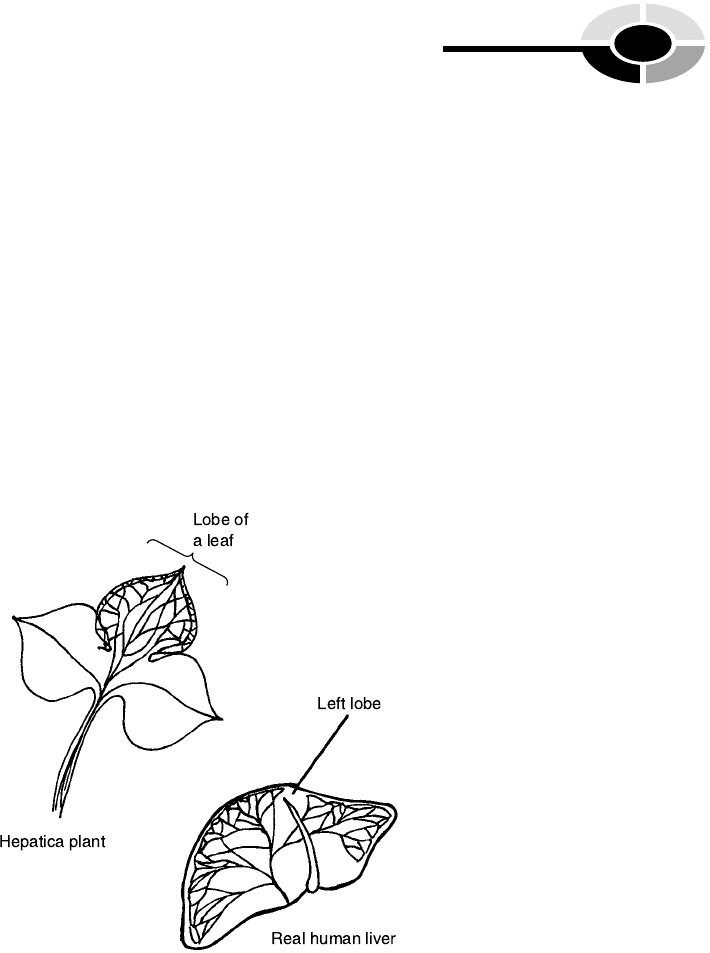
made of tightly packed mounds of partially rotted sphagnum (peat moss) and
various other plants. Peat is used as a fertilizer and is commonly burned as
fuel in Scotland, Ireland, and England, where there are many peat-containing
bogs.
Liverworts are given two alternate names – liverleaf and hepatica
(hih-PAT-uh-kuh). In humans and animals, the shorter word, hepatic
(hih-PAT-ik), literally ‘‘pertains to’’ (-ic) the ‘‘liver’’ (hepat). Obviously, the
words, liverwort and liverleaf, actually contain the smaller word, liver, while
hepatica contains the Latin word for liver. A glance at Figure 9.3 will reveal
the reason. The liverwort (liverleaf, hepatica) is a low-lying plant with brown-
ish-green, three-lobed leaves that resemble the human liver, which also has a
number of lobes. The resemblance of the hepatica plant leaves to the liver,
created the ancient belief that eating this plant cures jaundice (JAWN-dis)
and a number of other liver diseases!
LIVING HABITS AND REPRODUCTION OF THE
BRYOPHYTES
Because both mosses and liverworts are bryophytes (nonvascular plants),
they can live only in free-standing pools of water. Having no vascular
(vessel-bearing) system or roots to transport fluid, nutrients, and waste pro-
CHAPTER 9 Plants: Kings and Queens 143
[13:24 13/6/03 N:/4058 LAYMAN.751/4058-Alltext.3d] Ref: 4058 Layman: Biology Demystified All-text Page: 143 1-388
Fig. 9.3 The liverwort, liverleaf, or hepatica plant: Lobed leaves like the human liver.
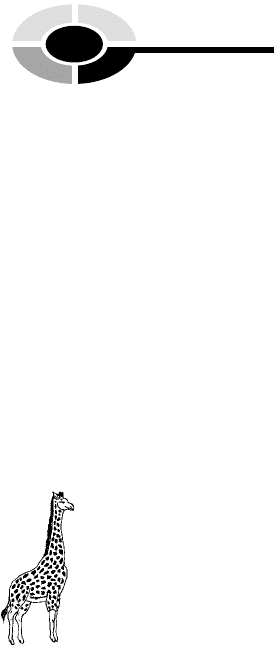
ducts, they must grow upon pools of water (however tiny and shallow). Such
a tiny pool might even occur in a shadowy cleft on the sun-baked face of a
desert rock. A pool even this small may be just enough to allow the bryo-
phyte plant to absorb water and nutrients into its nonvascular tissues, and
survive.
A water pool is also needed as a fluid medium, so that sperm cells can
travel from the male bryophyte plants and fertilize the female plants.
An Overview of the Tracheophytes
(Vascular Plants)
Figure 9.2 (A) showed some of the most basic anatomic features of the
tracheophytes (vascular plants). In addition to their inner system of hollow
passageways for transporting wastes and nutrients, this group of plants has
true stems and roots. The two types of vascular tissue within tracheophytes
are xylem (ZEYE-lem) and phloem (FLOW-em). Xylem comes from the
Greek for ‘‘wood,’’ because it often contains woody fibers that form the
harder part of a plant vessel system. Xylem is stiff enough to provide support
for vessel walls, and it also carries water and dissolved minerals upward into
the plant after they have been absorbed by the roots. Phloem derives from the
Greek for ‘‘bark.’’ While the outer bark of most vascular plants is tough and
dead, the phloem forms a softer inner bark composed of living tissue. The
phloem (living inner bark) contains vessels which carry sugars and proteins
synthesized in the leaves down towards the stem and roots.
Although all tracheophytes are vascular plants, some species produce
seeds, while the simpler types lack seeds.
The Ferns: Vascular Plants without Seeds
Ferns are the main group of seedless vascular plants. A fern is a slender plant
with feathery fronds (FRAHNDS) – split ‘‘leaves’’ that grow out along either
side of a central stem. Ferns reproduce by means of spores. The spores grow
in small brownish clusters on the back of the feathery frond leaflets. Ferns,
huge fern-like trees, and their close relatives grew and reproduced by the
billions in ancient tropical forests. Such forests of ferns covered vast stretches
of the Earth during the Carboniferous (car-buh-NIF-er-us) Period of the
[13:24 13/6/03 N:/4058 LAYMAN.751/4058-Alltext.3d] Ref: 4058 Layman: Biology Demystified All-text Page: 144 1-388
PART 3 Five Kingdoms of Life, plus Viruses
144
2, Order

[13:24 13/6/03 N:/4058 LAYMAN.751/4058-Alltext.3d] Ref: 4058 Layman: Biology Demystified All-text Page: 145 1-388
Paleozoic Era, 500 to 200 million years ago. Carboniferous literally ‘‘pertains
to carbon-carrying.’’ But it also has been nicknamed the ‘‘Age of Ferns.’’ The
Carboniferous Period gets its name from the great forests of ferns and related
plants that grew during this time, died out, and were compressed into massive
layers. After millions of years, the great pressure formed deep natural depos-
its of coal, oil, and natural gas. Because all of these ‘‘fossil fuels’’ are rich in
carbon atoms, naming their time of origin the Carboniferous Period or ‘‘Age
of Ferns’’ is very fitting.
Gymnosperms: Vascular Plants with ‘‘Naked
Seeds’’
The great majority of vascular plants (other than ferns and their fern-like
relatives) reproduce by means of seeds. One important group are the gym-
nosperms (JIM-nuh-sperms) or vascular plants with ‘‘naked’’ (gymno-)
‘‘seeds’’ (sperms). By naked, it is meant that the seeds of the gymnosperms
are exposed, and not enclosed within fruits.
As the Ancient World’s climate became cooler and drier, many of the vast
fern swamps of the Carboniferous Period died and dried up. Arising in their
place were the conifers (KAHN-uh-fers) or ‘‘cone-bearers.’’ The conifers, as
their name suggests, produce cones that hold their naked seeds. Most of the
conifers are evergreen trees or shrubs that bear cones. These conifers are truly
‘‘ever-green,’’ because they keep their green, needle-like leaves all year. The
thin leaves are an adaptation to cold, dry conditions in that their needle
shape gives them a small surface area exposed to the air, thus reducing
evaporation or drying of the conifer plant.
The conifers include pine trees, fir trees, spruce, larch, hemlock, and yew
bushes. Today, much of the still-natural land of the Northern Hemisphere is
covered by beautiful coniferous (kuh-NIF-er-us) forests, graced with tall
spruce, fir, and pine trees.
THE LIFE CYCLE OF A PINE TREE
Since pine trees and other conifers are called gymnosperms, it is important to
examine their typical life cycle, wherein their ‘‘naked seeds’’ play an impor-
tant role. Each of the major steps are described below. (Consult Figure 9.4
for a summary.)
CHAPTER 9 Plants: Kings and Queens 145
2, Web
3, Web
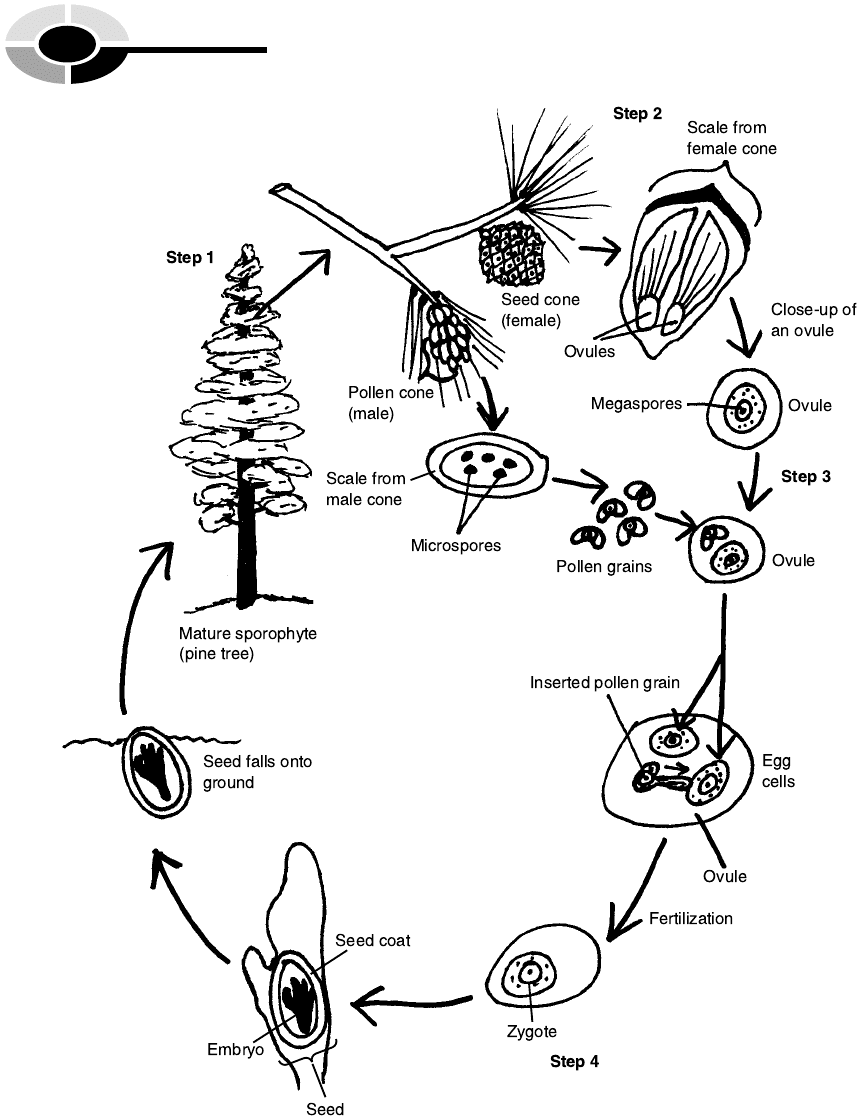
[13:24 13/6/03 N:/4058 LAYMAN.751/4058-Alltext.3d] Ref: 4058 Layman: Biology Demystified All-text Page: 146 1-388
PART 3 Five Kingdoms of Life, plus Viruses
146
Fig. 9.4 The life cycle of a pine tree.
